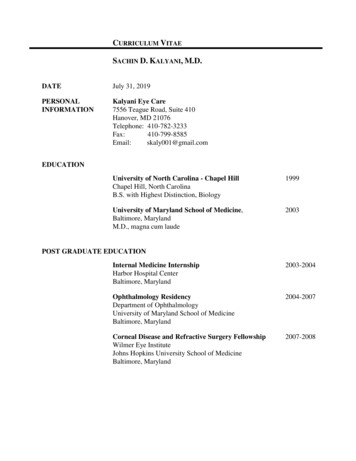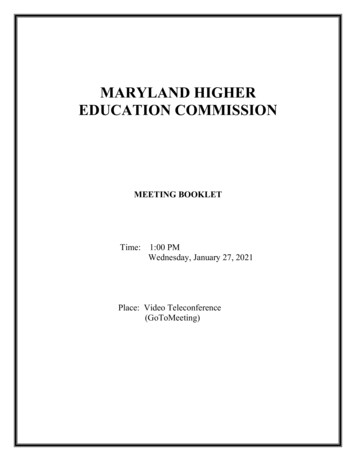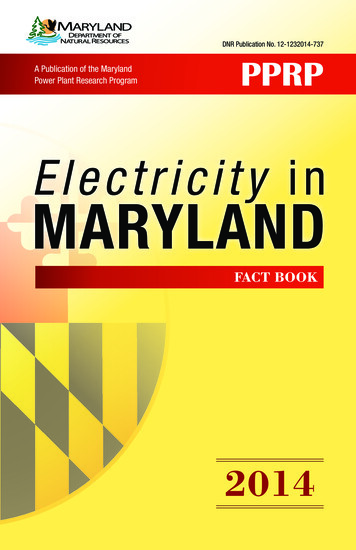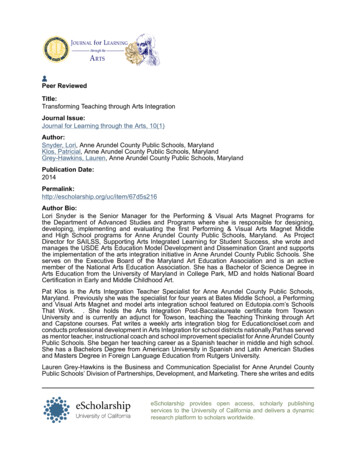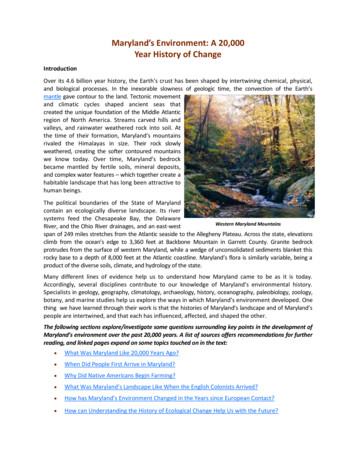
Transcription
Maryland’s Environment: A 20,000Year History of ChangeIntroductionOver its 4.6 billion year history, the Earth’s crust has been shaped by intertwining chemical, physical,and biological processes. In the inexorable slowness of geologic time, the convection of the Earth’smantle gave contour to the land. Tectonic movementand climatic cycles shaped ancient seas thatcreated the unique foundation of the Middle Atlanticregion of North America. Streams carved hills andvalleys, and rainwater weathered rock into soil. Atthe time of their formation, Maryland’s mountainsrivaled the Himalayas in size. Their rock slowlyweathered, creating the softer contoured mountainswe know today. Over time, Maryland’s bedrockbecame mantled by fertile soils, mineral deposits,and complex water features – which together create ahabitable landscape that has long been attractive tohuman beings.The political boundaries of the State of Marylandcontain an ecologically diverse landscape. Its riversystems feed the Chesapeake Bay, the DelawareWestern Maryland MountainsRiver, and the Ohio River drainages, and an east-westspan of 249 miles stretches from the Atlantic seaside to the Allegheny Plateau. Across the state, elevationsclimb from the ocean’s edge to 3,360 feet at Backbone Mountain in Garrett County. Granite bedrockprotrudes from the surface of western Maryland, while a wedge of unconsolidated sediments blanket thisrocky base to a depth of 8,000 feet at the Atlantic coastline. Maryland’s flora is similarly variable, being aproduct of the diverse soils, climate, and hydrology of the state.Many different lines of evidence help us to understand how Maryland came to be as it is today.Accordingly, several disciplines contribute to our knowledge of Maryland’s environmental history.Specialists in geology, geography, climatology, archaeology, history, oceanography, paleobiology, zoology,botany, and marine studies help us explore the ways in which Maryland’s environment developed. Onething we have learned through their work is that the histories of Maryland’s landscape and of Maryland’speople are intertwined, and that each has influenced, affected, and shaped the other.The following sections explore/investigate some questions surrounding key points in the development ofMaryland’s environment over the past 20,000 years. A list of sources offers recommendations for furtherreading, and linked pages expand on some topics touched on in the text:What Was Maryland Like 20,000 Years Ago?When Did People First Arrive in Maryland?Why Did Native Americans Begin Farming?What Was Maryland’s Landscape Like When the English Colonists Arrived?How has Maryland’s Environment Changed in the Years since European Contact?How can Understanding the History of Ecological Change Help Us with the Future?
What Was Maryland Like 20,000 Years Ago?Twenty thousand years ago Maryland’s landscape was very different.The climate was much colder, the Chesapeake Bay did not exist.There were no people, and mammoths, mastodons, bison, and giantbeavers roamed a landscape dominated by coniferous woods andmarshy tundra.Mammothshttp://newsimg.bbc.co.uk/media/This was the Ice Age: the most recent glacial episode in NorthAmerica, when extensive ice sheets covered much of North American and Europe. At the time of thisWisconsin Glaciation, ice up to one mile thick covered the land as far south as northern Pennsylvania,reaching its maximum extent between 18,000 and 20,000 years BP (Before the Present). Marylanditself was not covered by glacial ice, but its climate was highly influenced by the glaciers to the north.This glacial episode is also responsible for the formation oflarge portions of Maryland’s landscape. As the ice-sheetsretreated, meltwaters flushed down the rivers of the ancestralChesapeake and carved new channels across the coastal plain.These rivers carried stone rubble and sediment scraped up bythe glaciers and deposited this material in layers across a vastarea. The Chesapeake Bay as we know it first began to emergeabout 12,000 years ago, formed when a widely branchingnetwork of river channels joined to a single tidal river flowingalong the Atlantic continental shelf.In western portions of Maryland, higher elevations broughtcolder temperatures and a landscape reminiscent of morenorthern climes. Twenty thousand years ago, the flora andChesapeake Bay Satellite Image.(NASA image courtesy Jeff Schmaltz, MODISf a un aofM a ryl an dw erev e ryd i ffe re nt .Rapid ,forests were dominated by cold-adapted species like spruce, fir,and pine, and the piedmont and mountain regionsof the state had areas of tundra-like marshlands similar to thosewe know from Siberia, Alaska, and northern Canada. Prior to theglacial retreat, our familiar white-tailed deer, black bear, andbeaver coexisted with now-extinct megafauna.During the period between 20,000 and 12,000 years ago,large-scale, massive climatic changes transformed Maryland’senvironment. The greatest factors in shaping the environmentduring this time were the indirect effects of melting glacial icecaused by a gradual global warming trend.Melting glacierFurther Information: What Was Maryland Like 20,000 Years Ago?
When Did People First Arrive in Maryland?The first human beings arrived in Maryland sometime during the end of the last glacial period. Thereis some evidence of possible pre-Clovis occupation of the region as early as 18,000 years ago. It isgenerally agreed that by about 11,500 years ago, Paleoindian people using Clovis tools had moved intoMaryland and left evidence of their lives in the archaeological record.Image is a diorama of Paleoindians. Courtesy of The State Museum of Pennsylvania, Archaeology.Clovis PointAt the time people arrived in Maryland, the ice age was coming to an end, though the climate was stillmuch colder and wetter than it is today. Mobile hunters probably came into the region that is nowMaryland in pursuit of game. These Paleoindians lived in small family bands and moved frequently,following the migration of animals and keeping a seasonal pattern of rotation from place to place.Human beings arrived in Maryland on a wave of change as a series of large-scale climatic shifts beganto have a transformative effect on Maryland’s environment. A strong warming trend marked the onsetof the Holocene epoch, which caused tremendous changes to the landscape, plants, and animals of theregion. One of the biggest changes associated with this warming trend was a period of sea level risethat continues into the present.The coastlines of the Chesapeake Bay and its many tributaries were particularly attractive to humans settling in Maryland. In addition to being a highly productive estuary, the Bay also provided a highway ofrivers and creeks provided easy transportation routes. Archaeologists have found evidence that NativeAmerican campsites were focused along waterways. Pottery, tools, and shellfish remains from Marylandhave been recovered up and down the Atlantic coast – suggesting that objects and ideas were movedaround by waterborne trade.Throughout the Holocene, climatic conditions grew increasingly warmer and drier, causing formerlydominant animals and plants to be replaced by others who could thrive in the new landscape. By
10,000 years ago, if not earlier, the megafauna had become extinct, and by 9000 years ago, ourmodern mixed hardwood forests began to form. By about 8,000 years ago, a continuing warming trendkept glaciers melting and the resulting sea level rise flooded the continental shelf, causing the wideningof the Chesapeake Bay and its tributaries. Between 6,000 and 3,000 years ago, the modern outlines ofthe Chesapeake shore began to take shape.These significant changes in Maryland’s environment altered the ways in which people lived. Newtypes of tools, and new patterns in the size and location of campsites, were developed. New meansof obtaining and storing food took shape – ways which were better suited to Maryland’s evolvinghardwood forest landscape. This time of cultural adjustment to a new environment is called theArchaic period. Archaic peoples lived in small groups in widely-scattered encampments. Their liveswere largely nomadic, with hunting and gathering filling their subsistence needs.Archaeological evidence documents gradual changes in this way of life by the end of the Archaicperiod. Important shifts in the way Native people used the land and its resources define theTransitional Archaic period. The number and size of archaeological sites increases, suggesting thatdenser populations of people lived more intensively on the land. There is also archaeological evidenceof seasonal aggregation for ceremonial purposes. At this time, people also began using newtechnologies, including different kinds of tools and pottery.Dogs have accompanied humans since the earliest populations migrated into North America.Further Information: When Did People First Arrive in Maryland?
Why Did Native Americans Begin Farming?Archaeological evidence suggests that rather than abruptly shifting from hunting and gathering tofarming, Native Americans gradually incorporated food-growing into their lifestyle. The transition tofood growing in eastern North America was not a revolution, but a nuanced evolution. And Nativepeoples across America became farmers at different times and in different ways in response to adiversity of needs, beliefs, and ecological conditions.Apart from growing food, Native Americans actively “managed” the landscape by burningundergrowth and forest litter to make nut gathering easier and to facilitate hunting. Earlyhistorical accounts make mention of park-like forests:“Neare their habitations is little small wood or old trees on the ground by reason of their burningof them for fire. So that a man may gallop a horse amongst these woods any waie,but where the creekes or Rivers shall hinder. ” John Smith 1608.John Smith, A True Relation of Such Occurrences and Accidents of Noate as Hath Hapned inVirginia, (1608), in Lyon Gardiner Tyler, ed., Narratives of Early Virginia, 1606-1625(New York: Charles Scribner's Sons, 1907, p.101).It was during the Transitional Archaic time period that Native Americans firstbecame food growers by encouraging useful plants in and around their campsites. These acts formed the beginnings of a food production system which hadfar reaching effects on many aspects of culture – from the size of settlements,to mobility, to the health of individuals, to social and political relationships.Clear lines of evidence from the Midwestern United States document that atcampsites located on alluvial floodplains weedy plants were tolerated, encouraged,and eventually propagated. These acts of husbandry ultimately formed asystem of Native horticulture that was unique to the Eastern Woodlands ofNorth America. Sunflower, sumpweed, cucurbit gourd, knotweed, chenopod,maygrass, and little barley were grown. Together, these crops are referred toas the Eastern Agricultural Complex. While wild relatives of all of these plants persist in nature, thecultivated types grown in prehistory are now mostly extinct.The tropical cultigens corn (or maize), beans, and squash, which feature soprominently in early colonial accounts of the New World, were actuallylatecomers to the farm fields of the Eastern Woodlands. In the Midwest andon the Allegheny Plateau here in the East, maize was incorporated into thegardens of Indians who had a long history of growing the crops of theEastern Agricultural complex. In these areas, we believe that maize firstappeared in small quantities and at scattered locations after AD 200. Forcenturies maize was a minor crop in these areas. After AD 1100, farming economies focused on maizeflourished, and beans, fleshy squashes, and pale-seeded amaranth also become archaeologicallyvisible.
Here in Maryland and Virginia, very different patterns of prehistoric plant useare evident east and west of the Blue Ridge Mountains. To the west, theMidwestern pattern prevails – there is evidence of pre-maize agriculture, andmaize occurs at some Middle Woodland period sites. On the piedmont andcoastal plain, however, the story is a bit different: there is no convincingevidence that pre-maize crops were ever an important part of the Native foodsystem. In these areas, maize first occurred around A.D. 1100, and all earlymaize remains in the Chesapeake region have been found at archaeological sites thought to haveceremonial or political significance. This suggests that maize may have served an important symbolic orritualistic role as well as being a food plant.These differences in the timing and traditions associated with becoming farmers reflect the differencesin the ecological settings and culture history of prehistoric Native Americans. One explanation for thedifferences in the adoption of maize (as a food) and sedentary farming (as a lifestyle) in the Chesapeakeregion is that the Bay and its many estuaries provided a food-rich “breadbasket.” A great variety of wildfood resources were easily accessible via waterborne travel.The first English visitors to the Americas described maize as “corne” (corn) – which was their word forwheat or other staple starchy grain.The effects of prehistoric farming on Maryland’s environment are difficult to discern. We know fromearly colonial narrative accounts that the Chesapeake Indian peoples managed the forest understory forhunting and gathering, and cleared land for gardens. These activities would have increased soil erosionand modified the natural succession of plant species. The opening of arable land would also havecreated more forest edge – resulting in an increase in the diversity of plant and animal life. Hunting,fishing, and gathering activities would also have affected local biology. Growing populations living inlarger, more concentrated communities certainly impacted Maryland’s landscape. But the toll ofhumans as ecological factors prior to the time of European contact remains incompletely understood.Innovations in food production throughout the Woodland period were intertwined with cultural,political, and social changes. Horticulture enabled people to stay for longer periods of time in one place,which resulted in the development of more complex social and political relationships. We see thematerial expression of cultural identity and beliefs in Woodland period artifacts. These stylistic patternsreveal complex networksof communication andexchange throughout theMiddle Atlantic region.By the Late Woodlandperiod there is evidencethat populations hadgrownsignificantly,and that people livedin larger, year-roundvillages organized ame time, archaeologyFrom The History and Present State of Virginia, by Robert Beverly, 1705.revealsbigchangesin horticulture (with the adoption of maize agriculture), innovations in tool and weapon technologies,the creation of new pottery styles, and the practice of complex burial rituals.Further Information: Why Did Native Americans Begin Farming?
What Was Maryland’s Landscape Like When the English Colonists Arrived?The first written accounts of Maryland made by European explorersdescribe rich and abundant landscapes of forest and water. TheChesapeake Bay was the stage for the earliest direct contact withMaryland and it was central to the initial experiences of Europeanvisitors and the records that they made. The Bay supported a diverseweb of resources that provided food and which represented economicpotential for the colonial endeavor.Early historic accounts of Maryland include detailed descriptions of boththe physical and cultural landscapes: a rich estuary flanked by marsh andswamplands, intertwining waterways, a gentle plain of locally-diverseforests, and a network of human communities concentrated in riversidevillages where Native Americans plied waterways and trails and managedhunting grounds, nut groves, and gardens. The colonists observed thatcomplex social and political relationships linked the groups of NativeAmericans they encountered.History speaks of the natural cycles of want and plenty in the Chesapeakeregion. During the early summer the rivers, farm fields, and forest edgesproduced abundant foods. Thiswas followed by a plentifulautumn with a variety of nuts,Marshlandmaize, and fall fruits. Dried andsalted foods were stored for winter use. But, according to mostaccounts, these stores were exhausted long before springtime,and a “starving time” followed when game was scarce andIndians lived almost exclusively on bark, oysters, and plant tubers. The early chroniclers mentionthe mobility of Native groups – which allowed for flexibility in following food resources during theselean times, and in responding to the weather. The colonists suffered from conventions of land ownership,From The History and Present State of Virginia, by Robert Beverly, 1705.
“ that aboundance of fish, lying so thicke with their heads above the water, as for want of nets(our barge driving amongst them) we attempted to catch them with a frying pan”Smith, John, Generall Historie of Virginia. In P.L. Barbour, ed., The Complete Works of Captain JohnSmith (1580-1631), Vol. II. (Chapel Hill: University of North Carolina Press, 1986).which offered less flexibility in terms of responding to seasonal cycles. Being anchored to their farms, earlysettlers suffered devastating privation and starvation.European colonists settled in Maryland during a cool time period in North America and Western Europe.This time is referred to as the “Little Ice Age,” which lasted from about AD1500 to AD1850.Conflicts attendant to the colonial encounter had the effect of disturbing Native American settlement patterns,moving people from their traditional homes and changing the relationships between Native groups.At the time of contact, the forests of the Eastern Woodlands were majestic. Variable mixed hardwoodforests formed a tall, dense canopy which dominated the land. Maryland’s forest resourcesrepresented an economic opportunity for the colonists. They used wood domestically for building boats,homes, and farm structures. Timber was also exported to England, where a crisis of deforestation madeit a highly valuable commodity.At the time of the colonial encounter,Maryland was home to numerous animals nowextinct or extirpated: Wapiti (Eastern elk),woodland bison, passenger pigeon, and theCarolina parakeet were common, and blackbear, timber wolf, mountain lion, and bobcatranged throughout the state.Eastern Elk- courtesy of AudubonPassenger Pigeon- courtesy of AudubonCarolina Parakeet - courtesy of Audubon
There is evidence that 17th-century farmers on the Chesapeake colonial frontier made useof Indian fields which were already cleared of forest cover and were located on the mostproductive soils adjacent to waterways.European exploration and settlement of the New World was primarily an economic venture: colonistssought resources to finance the colonies, to compensate their financiers, and for personal gain.Colonial ideas of land ownership and resource management reflect a focus on industry and trade.Significant Events Associated with Contact, Exploration, and Colonization1492-1607 - Early European contacts and exploration of Eastern North America1524 -Earliest written record by Giovanni da Verrazano describes the Chesapeake Bay region1571-1585 - Attempted colonization of the region1607 -First successful English colony established at Jamestown, Virginia1634 -Saint Mary’s City was established and Maryland was foundedFurther Information: What Was Maryland’s Landscape Like When the English Colonists Arrived?
How has Maryland’s Environment Changed in the Years since European Contact?Contact and the colonization of North America brought unprecedented changeto the landscape and in the role of human beings as agents of ecological change.The colonial encounter marked the beginning of a tremendousacceleration in the rate of human-induced environmental change.European colonists brought with them new attitudes about land use,transforming the land in accord with their economic needs and in response tothe varying qualities of agricultural terrain. In Tidewater Maryland, tobacco varieties imported from the West Indies were grown with great success,fueling an economy built on slave labor. Native forests in these portions ofthe state were cleared faster and more extensively than in northern andwestern areas.In the early days of the colony, European settlers themselves slowly clearedthe land . Their pigs, cattle, horses, and fowl were fenced out ofhouseyards and ranged free in the Maryland woods. The activities of thelivestock were very effective in clearingthe understory andpreventing the regeneration of forests. Farming practices -- especiallytobacco agriculture, which was so widespread in Tidewater Maryland -included the frequent clearing of fields and their later abandonment due toexhausted soils, which led to the fragmentation of forests and the creationof patchwork landscapes.The late 1800s and early 1900s witnessed the most extensive deforestationin Maryland, when approximately 80 percent of the land was cleared oftrees. The result was a heretofore unprecedented homogeneity of theMaryland landscape.The colonial transformation and the centuries which followed have caused tremendous changes inMaryland’s plant and animal communities. Habitat destruction, unregulated hunting, and increasedcompetition from introduced exotic species and diseases resulted in the wholesale decline in wilderness-dependent species and a corresponding rise in species that favored agricultural landscapes and humanhabitation sites. This decline and loss has significantly disturbed Maryland’s ecological balance.Some Highlights in Maryland Species ChangeOverhunting was responsible for the collapse of the fur trade by the middle 1600s.The fossil pollen record reveals an explosion of ragweed pollen about 350 years ago that coincides with massive forest clearing and agricultural expansion following European colonization.Colonial hunting and habitat destruction diminished the range of bear, elk, big cats, andwoodland bison.The passenger pigeon – once the most common bird in Eastern North America- was hunted to extinction (the last bird died in captivity in 1914).Piedmont and mountain regions of Maryland once supported forests of giantchestnut trees that were decimated by a blight introduced in the 1920s.
Dutch Elm disease (introduced in 1928) has significantly reduced the elm tree.More recently, a small parasite has diminished the once-common hemlock tree.Study of sediment cores offers a chronology of forest development and change. By examining plantpollen types and rates of sediment accumulation, we can learn about environmental change.Ecological transformation continued as Maryland’s population burgeoned. Resources were harvested tofuel development of towns and cities, industries took shape, and political boundaries were shaped anddefended. The early years of the republic saw a huge expansion in canal and highway constructionwhich improved access to undeveloped areas and opened more land to farming, timber harvesting, andmining. The resulting habitat destruction pushed many species out of their native areas or intoextinction, and invasive, opportunistic species moved in to fill the void. Deforestation led to extensivesoil erosion – the effects of which were visible from the mountains to the sea.Early industries in Maryland included charcoal and bog iron production. Their furnaces consumedlarge quantities of wood, and it is estimated that Maryland’s coastal plain forests were reducedby 30 percent by the year 1775.By the mid-19th century, the development of coal, steam, and steel fueled greater industrial expansion.The period witnessed urban development, civil war, and an influx of European immigrants to Maryland’sshores. Changes in Maryland agriculture characterize this period as well, as farming shifted toward thewestern frontier.Reproduced from 1854 Engraving of Mt. Savage Iron-Works in: Green Glades & Sooty Gob Piles, The MarylandCoal Region’s Industrial and Architectural Past, Maryland Historical Trust.“The real legacy of European Colonization has been the transformation of a highly variable, almostcompletely forested landscape into a herbaceous-dominated system, interspersed with differentsized fragments of secondary forest in different stages of succession. . . It is difficult to predict whatwould happen to today’s largely deforested landscape if it were subjected to the kind of climatechanges seen in the past.” Grace Brush 2001: 57.Further Information: How has Maryland’s Environment Changed in the Years since European Contact?
How can Understanding the History of Ecological Change Help Us with the Future?The Maryland landscape we know today is the product of millions of years of natural processes. Untilrecently, that landscape was predominantly shaped by the ecological functions of soil, climate,hydrology, and slope. Global-scale shifts in climate were responsible for governing ecological change inMaryland. But the arrival of humans on the land introduced a new element which through time provedto be an increasingly powerful ecological force which continues to accelerate into the present.“Environment may initially shape the range of choices available to a people at a given moment, but thenculture reshapes environment in responding to those choices.” (William Cronon, 1993:13)Looking at the history of Maryland’s environment, we recognize that it has never been static. Thefirst European explorers to the New World encountered not a primordial landscape untouchedand unchanging, but a dynamic realm of interconnected physical, biological, and cultural forces.Understanding the interaction of these forces and their effects upon a malleable landscape puts theconcept of a ”virgin wilderness” into a context where change is constant and humans long played animportant roleWe share a history with all the Marylanders that have comebefore us. By being human, through the acts that fulfill ourneeds for food, shelter, and transportation, as well as our social,political, and spiritual desires, we effect and are affected by theland we live upon. As Marylanders we share a heritage oftransforming our environment.We live in a time where concerns about global warming,deforestation, overpopulation, and our food supply loom large.History helps us to understand the effects of both our consciousDeforestationand inadvertent actions upon the environment. And hopefully,an understanding of our past will help us to be better stewards of our home and its resources.Further Information: How can Understanding the History of Ecological Change Help Us with the Future?
GlossaryArable: Land favorable to the cultivation of crops or land upon which crops are grown.Archaic: The Archaic cultural period (7500 B.C. to 1000 B.C) is divided into the Early Archaic (7500 B.C. 6000 B.C.), Middle Archaic (6000 B.C. – 3500 B.C.) and Late Archaic (3500 B.C. – 1000 B.C.) sub ic Ceramic Web Page/Prehistoric Prehistory.htmArcheobotany: Or Paleoethnobotany is the study of archaeologically-recovered plant artifacts tointerpret how people in the past used and interacted with plants.Clovis: A distinct Paleoindian group originally named for a distinctively shaped fluted stone spearpointused to hunt megafauna. The Clovis people are generally regarded as the earliest human inhabitants ofthe New World.Cultivation: The act of growing plants.Dichotomous Key: Is a tool that allows the user to determine the taxomonic identity of items in thenatural world, such as plants and animals. The key is a written device constructed from a series oforganized statements which represent mutually exclusive choices. Identification is made by selectingchoices based on the user’s comparisons with unknown specimen until a conclusion is reached.Domestication: The process through which a plant (or animal) is adapted to life in close associationwith and to the benefit of humans.Eastern Woodlands: The temperate forests zones of eastern North America stretching from theMississippi River east to the Atlantic ocean, and excluding the tropical forests of the south.Extinct: A plant or animal species which no longer exists.Extirpated: A local extinction, where a species ceases to exist in one area, but still exists elsewhere.Flotation: A process to separate organic remains from archaeological soils.Holocene: Is a geological epoch which began approximately 10,000 years ago and continues into thepresent.Horticulture: The art and science of growing plants.Husbandry: The act of caring for or managing plants and animals for human benefit.Little Ice Age: A modest cooling of the northern hemisphere following a warmer era (the MedievalWarm Period) and spanning from the 1500’s through the mid 19th century.Ice Age: A geologic period of long-term reduction in the Earth’s temperature which results in anexpansion of the continental and polar ice sheets.Light Microscope: Or optical microscope is a type of microscope which uses visible light and a systemof lenses to magnify images of small specimens.
Glossary continued Mantle: A thick layer of molten rock on which the earth’s crust floats.Megafauna: Specifically, the Pleistocene Megafauna, the giant land animals of the last ice age likemammoth, mastodon and giant bear which are now extinct.Morphology: The form (structure, shape, color, pattern) of an organism or of a part of an organism.Non-Indigenous: A plant or animal species that is introduced to a geographical area. Not native, analien or exotic species.Paleoethnobotany: Or Archeobotany is the study of archaeologically-recovered plant artifacts tointerpret how people in the past used and interacted with plants.Paleoindian: The Paleoindian cultural period (10000
What Was Maryland Like 20,000 Years Ago? Twenty thousand years ago Maryland’s landscape was very different. The climate was much colder, the Chesapeake Bay did not exist. There were no people, and mammoths, mastodons, bison, and giant beavers roamed a landscape domina
